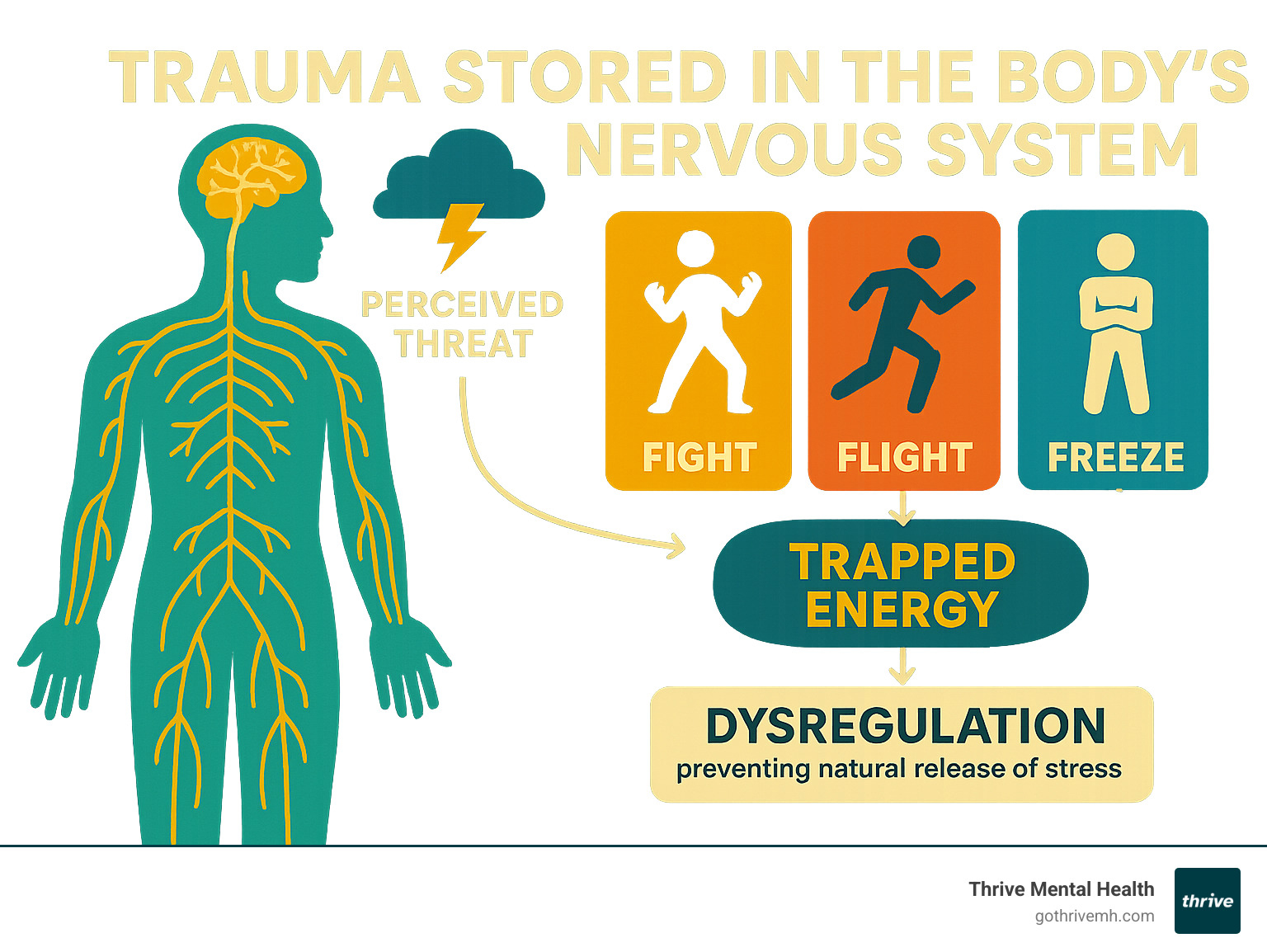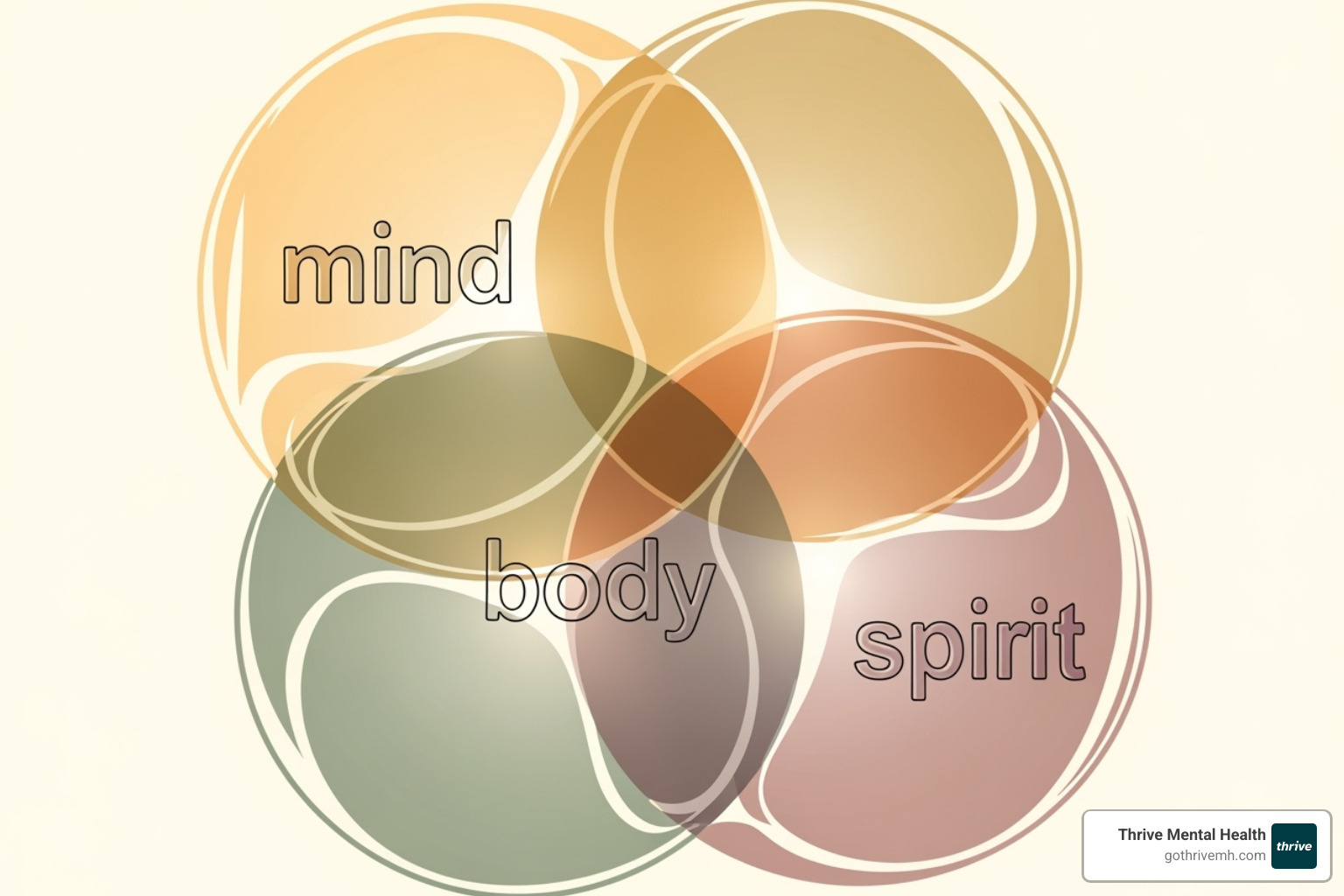Unlocking Emotional Freedom: The Benefits of Somatic Therapy

Understanding the Benefits of Somatic Therapy
If you’re seeking lasting calm and relief from stress, understanding the benefits of somatic therapy is a powerful step. This unique approach connects the mind and body to heal deep wounds and release tension.
Somatic therapy offers many advantages, including:
- Releases Stored Trauma: It helps free the body from past stressful experiences and can reduce PTSD symptoms.
- Reduces Chronic Pain: By addressing physical tension, it can ease long-standing aches.
- Boosts Emotional Control: Learn to manage feelings and respond to stress more calmly.
- Increases Body Awareness: Become more in tune with your physical self for greater self-understanding.
- Builds Resilience: Develop stronger tools to bounce back from life’s challenges.
Trauma or stress can get “stuck” in our bodies, leading to physical and emotional challenges. Somatic therapy offers a path to let go of these burdens.
As Nate Raine, CEO of Thrive, I’ve seen how the benefits of somatic therapy can be transformative for those seeking emotional freedom. We champion innovative solutions that address critical mental health needs.

What is Somatic Therapy and How Does It Heal?
Stress that causes aching shoulders or a knotted stomach is your body telling a story. Somatic therapy, from the Greek word “soma” (body), is an approach to mental health that works directly with this mind-body connection. It acknowledges that your mind and body constantly influence how you feel, think, and react.
Dr. Peter Levine, a pioneer in this field, developed Somatic Experiencing (SE). He observed that wild animals often shake or tremble to release intense energy after escaping danger. Humans, however, often suppress this natural release, causing energy from stressful or traumatic events to get “stuck” in the nervous system.
This relates to our Autonomic Nervous System (ANS), which controls automatic responses like breathing and heart rate. When faced with a threat, the ANS activates the fight, flight, or freeze response. If you can’t fight or flee, your body might freeze, leaving you feeling numb or disconnected long after the danger has passed. Somatic therapy gently helps your body move through these stuck states. Research on the psychobiology of the freeze response confirms its importance in healing post-traumatic stress.
Unlike talk therapy’s “top-down” approach (starting with thoughts), somatic therapy uses “bottom-up processing.” It begins with your body, helping you become aware of internal bodily signals (interoception) and your body’s position in space (proprioception). By tuning into these physical cues, you can gently access and release unresolved trauma. At Thrive Mental Health, we believe nurturing this powerful connection between physical and mental health is key to holistic well-being for our clients across Florida.
The Core Benefits of Somatic Therapy for Mind and Body

Somatic therapy offers more than symptom relief; it opens the door to genuine emotional freedom. This approach recognizes your body’s inherent wisdom, which can be accessed through mindful attention.
The benefits of somatic therapy create a ripple effect of well-being in daily life:
- Stress Reduction: Your nervous system learns to settle into a calmer state, making it easier to find peace during challenges.
- Increased Resilience: You develop stronger internal resources to steer life’s ups and downs with gentle strength.
- Deeper Self-Awareness: You learn to notice how emotions show up in your body, using this body wisdom as a trusted guide.
- Improved Self-Esteem: Reconnecting with your authentic self and trusting your body’s signals helps you feel more at home in your own skin.
These benefits work in harmony, creating a sense of well-being that touches every aspect of your life.
1. Releases Stored Trauma and Reduces PTSD Symptoms
Do you feel like a past difficult experience is still living in your body? One of the most profound benefits of somatic therapy is its ability to help release that “stuck” trauma.
During overwhelming events, our body’s stress response (fight, flight, or freeze) can get interrupted, trapping that intense energy in the nervous system. This “nervous system dysregulation” can lead to chronic tension, anxiety, or symptoms of Post-Traumatic Stress Disorder (PTSD).
Somatic therapy offers a safe way for your body to complete its response cycle. Instead of just talking about the event, you work with the physical sensations linked to it. This isn’t about reliving trauma but about allowing your body to naturally discharge the pent-up energy in a controlled, supportive environment.
The effectiveness of this approach is encouraging. In one study, 44% of participants lost their PTSD diagnosis after engaging in somatic therapy. A randomized controlled study on PTSD further supports how somatic approaches can significantly reduce trauma-related symptoms. At Thrive Mental Health, we know that somatic therapy offers an embodied and powerful path toward healing for individuals throughout Florida.
2. Alleviates Chronic Pain and Physical Tension
Stress often manifests physically as a knot in your shoulders, neck pain, or a tight jaw. Our bodies hold unresolved emotional experiences, which can cause very real symptoms like unexplained aches, muscle tension, headaches, and digestive issues. The saying “the issues are in our tissues” highlights this deep connection.
When chronic pain doesn’t respond to traditional treatments, it’s often because the body is still holding onto past stress. The benefits of somatic therapy include gentle techniques to release these deep-seated tension patterns. By guiding your nervous system back to a balanced state, it can reduce the muscle contraction that contributes to long-lasting pain.
The Alexander technique, a type of somatic movement, illustrates this power. A 2008 study found that people with chronic pain who took Alexander technique lessons for a year saw an 86% reduction in days they experienced pain. At Thrive Mental Health, we see clients across Florida find significant relief from tension in common stress zones like the neck, shoulders, jaw, and back.

3. One of the key benefits of somatic therapy is improved emotional regulation
Life is full of challenges, and how we handle our feelings matters. The benefits of somatic therapy shine here, teaching you not just to understand emotions, but to feel and process them in your body in a healthy way.
If you ever feel overwhelmed by strong emotions or triggers, somatic therapy offers practical tools. By paying attention to what’s happening in your body when emotions arise, you can better handle discomfort without feeling swamped.
You’ll build a strong emotional toolkit with valuable coping skills and self-soothing techniques to prevent emotional spirals. The goal isn’t to stop feeling, but to grow your capacity to experience emotions without getting stuck. This leads to a greater sense of internal control, allowing you to bounce back from life’s stressors with increased resilience. For more guidance, explore our expert tips on coping with trauma for better mental health, a resource we provide for our community in Florida and beyond.
4. Deepens Body Awareness and Self-Connection
In our busy world, it’s easy to become disconnected from our bodies, ignoring building tension or discomfort. This can lead to chronic pain, body image issues, and a general sense of feeling “off.” One of the key benefits of somatic therapy is guiding us back home to ourselves.
Learning to listen to your body becomes a practice of curiosity, not judgment. Noticing shallow breathing when you’re anxious or a clenched jaw when you’re frustrated is valuable information your body is sharing.
This reconnection is especially healing for those with body image issues, fostering a relationship based on respect and appreciation. This process naturally fosters self-compassion, as you learn to notice when you need rest, movement, or comfort.
The mindfulness developed through somatic work extends beyond therapy. You might find yourself taking a deep breath before a difficult conversation or noticing early signs of stress. This embodied awareness becomes a reliable compass for daily life.
At Thrive Mental Health, we understand this powerful mind-body connection. Our Mindfulness & Meditation Virtual IOP programs incorporate these principles, helping individuals in Florida and beyond develop this essential skill.
Common Techniques and Modalities in Somatic Therapy
Somatic therapy is a body-centered approach. While you’ll talk with your therapist, the focus is on what your body is telling you through sensations and movements. Your therapist acts as a guide, creating a safe environment to explore these experiences at your own pace. This sense of safety is paramount, as it allows your nervous system to relax and begin healing.

Key Exercises Used in Sessions
Somatic therapists use a toolkit of techniques to help you connect with your body.
- Grounding: Simple exercises, like feeling your feet on the floor or using the 5-4-3-2-1 technique, anchor you in the present to reduce anxiety.
- Body Scan: Systematically bringing attention to different parts of your body to notice sensations without judgment.
- Breathwork: Conscious breathing techniques, like deep belly breathing, help regulate your nervous system and release trapped energy.
- Pendulation & Titration: These techniques involve gently moving between sensations of distress and comfort, processing difficult emotions in small, manageable increments to avoid overwhelm.
- Resourcing: Identifying and strengthening internal or external resources (like a peaceful memory or a personal strength) that bring feelings of safety and calm.
- Mindful Movement: Practices like gentle yoga or Tai Chi help release physical tension and express emotions non-verbally.
Different Types of Somatic Therapy
“Somatic therapy” is an umbrella term for several distinct approaches.
- Somatic Experiencing (SE): Developed by Dr. Peter Levine, SE helps discharge trapped survival energy by tracking bodily sensations.
- Sensorimotor Psychotherapy: Blends talk therapy with body-centered interventions, focusing on posture and movement to resolve trauma.
- The Hakomi Method: A mindfulness-centered therapy that uses present-moment awareness to uncover core beliefs held in the body.
- Bioenergetic Analysis: Combines bodywork and psychotherapy to release chronic muscular tension.
- Trauma-Informed Yoga: Uses gentle movements and breathwork to help trauma survivors reconnect with their bodies safely.
Somatic Therapy vs. Talk Therapy: What’s the Difference?
While both somatic therapy and traditional talk therapy (like CBT) aim to promote healing, they take different paths. The fundamental difference lies in their focus and processing style.
- Focus: Talk therapy primarily centers on the mind—your thoughts and beliefs. Somatic therapy focuses on the body and how emotions are physically held.
- Processing Style: Talk therapy typically uses “top-down processing,” starting with thoughts and working down to the body. Somatic therapy is “bottom-up,” beginning with bodily sensations and allowing insights to emerge from there.
- Trauma Treatment: Talk therapy often involves reframing the story of a traumatic memory. Somatic therapy addresses how trauma is held in the nervous system, helping the body complete stress responses, often without needing to retell the story in detail.
- Techniques: Talk therapy relies on conversation and cognitive exercises. Somatic therapy incorporates breathwork, movement, and tracking physical sensations.
Many people find the greatest benefits of somatic therapy when it’s integrated with other approaches. At Thrive Mental Health, our comprehensive approach for clients in Florida often incorporates body-centered techniques alongside traditional methods. To learn more, see our guide on understanding the different types of mental health therapy.
Finding a Somatic Therapist in Florida

Ready to explore the benefits of somatic therapy? Finding the right therapist is a crucial step. It’s vital to connect with a professional in Florida who has specialized training and experience in this body-centered field.
Look for professionals with specific qualifications, such as a Somatic Experiencing Practitioner (SEP) certification, alongside a professional license like LCSW, LMHC, or Psychologist. A strong therapeutic relationship is key, so don’t hesitate to ask questions during an initial consultation to see if it’s a good fit.
Consider asking a potential therapist:
- What is your training in somatic therapy?
- Which somatic modalities do you use?
- How do you integrate these techniques into sessions?
- What is your experience with concerns like mine?
- How do you ensure a safe environment?
Taking the step to seek professional help is a powerful move. As highlighted in The Benefits of Utilizing Mental Health Services, finding the right match is essential. At Thrive Mental Health, we’re here to support you in finding compassionate care through our programs across Florida.
Frequently Asked Questions about the Benefits of Somatic Therapy
It’s natural to have questions about the benefits of somatic therapy. Here are some common inquiries we receive from people across Florida.
What conditions see the most benefits from somatic therapy?
Somatic therapy is helpful for many conditions where stress and trauma show up physically. It’s especially powerful for:
- Post-Traumatic Stress Disorder (PTSD): It helps release trapped trauma energy and calm the nervous system. Our Areas of Care: Trauma programs often integrate these principles.
- Anxiety and Panic Disorders: It settles the nervous system and reduces physical symptoms.
- Depression: It can address the body’s role in emotional states, helping to lift physical sluggishness.
- Chronic Pain and Physical Tension: It helps unwind deep-seated patterns of tension.
- Grief and Loss: It allows the body to process the physical sensations of sorrow.
- It also supports recovery from Substance Use Disorders (SUDs), improves Body Image Issues, and helps with Relationship and Attachment Issues.
Is somatic therapy scientifically proven?
Yes, the scientific evidence for somatic therapy is growing and promising. While research is still expanding compared to older therapies like CBT, key findings support its effectiveness.
Studies, including randomized controlled trials, have shown that somatic approaches are effective in reducing PTSD symptoms. Neuroscience research on nervous system regulation and interoception (the ability to sense the body’s internal state) provides a strong scientific foundation for its body-focused methods. Additionally, research on related practices like the Alexander technique demonstrates clear benefits for chronic pain.
Can I do somatic exercises on my own?
Yes, many basic somatic exercises are wonderful self-care tools for daily stress management. You can try:
- Grounding: Feeling your feet on the floor or using the 5-4-3-2-1 technique.
- Breathwork: Practicing gentle belly breathing.
- Body Scan: Briefly checking in with different parts of your body.
- Mindful Movement: Simple, conscious stretches or a mindful walk.
However, for deep trauma work or complex emotional challenges, working with a trained somatic therapist is essential. A therapist provides a safe, guided space, prevents you from feeling overwhelmed, and tailors techniques specifically for you. Use solo exercises for self-care, but rely on a professional for deeper healing.
Conclusion: Take the First Step Towards Embodied Healing
Your healing journey is unique, but you don’t have to walk it alone. The benefits of somatic therapy offer a powerful path that honors the mind-body connection. By addressing stored trauma, reducing chronic pain, and improving emotional regulation, you create space for a more integrated and fulfilling life.
This holistic approach recognizes that true wellness is about feeling different in your body. At Thrive Mental Health, we are committed to providing flexible, expert-led care custom to your needs. We believe in the transformative power of somatic therapy and are here to support you.
If you’re dealing with trauma, chronic pain, or overwhelming emotions, or simply want to feel more connected to yourself, somatic therapy could be the missing piece. We invite you to learn how the benefits of somatic therapy could support your healing.
We offer virtual and in-person IOP and PHP programs throughout Florida, including Tampa Bay and St. Petersburg. Taking the first step is a brave act. You deserve to feel at peace in your body. Explore our virtual and in-person treatment programs in Florida and let us support you on your path to a more embodied you.
One thought on “Unlocking Emotional Freedom: The Benefits of Somatic Therapy”
Comments are closed.